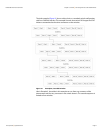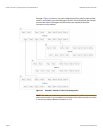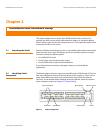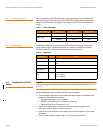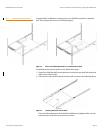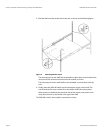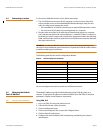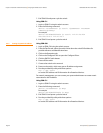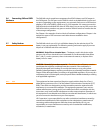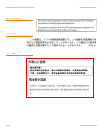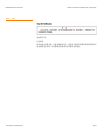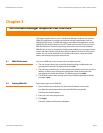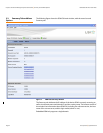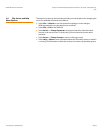
LSI Corporation | September 2010 Page 29
LSISAS6160 SAS Switch User Guide Chapter 2: Installation and Hardware Setup
| Connecting SAS and SATA Hardware
2.6 Connecting SAS and SATA
Hardware
The SAS6160 switch centralizes management for all SAS initiators and SAS targets in
the SAS domain. The SAS ports on the SAS610 switch are by default both in ports and
out ports. Depending on the requirements, you can attach each port to a SAS host bus
adapter, a SAS or SATA JBOD, a RAID array, or a SAS expander. You cannot connect the
SAS6160 switch to individual SAS drives or SATA drives. You can use any SAS port on the
SAS6160 switch to cascade to any port on another SAS6160 switch to increase the size
of the storage configuration.
See Chapter 1 for examples of various kinds of hardware configurations. Chapter 1 also
explains the types of SAS connectors and cables that are needed for these
configurations.
2.7 Safety Notices The SAS6160 switch uses a 3 V coin cell lithium battery for the real-time clock. The
battery is not user-replaceable. The following warning and caution apply if you must
dispose of a SAS6160 switch for some reason.
WARNING: Risk of fire or chemical burn – The battery used in this device might
present a risk of fire or chemical burn if mistreated. Do not disassemble, heat above
60 ºC (140 ºF), crush or puncture, short-circuit external contacts, or dispose of the
battery in fire or water.
CAUTION: Potentially hazardous material – The lithium coin cell battery contains
perchlorate that might be considered hazardous material. If the used battery is
physically damaged and is leaking, Do not ship the battery to a recycling center.
Handling a damaged battery exposes you and others to potentially hazardous material.
Dispose of the damaged battery according to all applicable regulations. If you recycle a
used battery that is not damaged, use the proper facilities. Handle the battery according
to all applicable regulations.
2.7.1 FCC This equipment has been tested and found to comply with the limits for a Class A
digital device, pursuant to Part 15 of the Federal Communications Commission (FCC)
Rules. These limits are designed to provide reasonable protection against harmful
interference in a commercial installation. This equipment generates, uses, and can
radiate radio frequency energy and, if not installed and used in accordance with the
instructions, may cause harmful interference to radio communications. Operation of
this equipment in a residential area is likely to cause harmful interference, in which case
you must correct the interference at your own expense.
LSI Corporation, is not responsible for any radio or television interference caused by
unauthorized modification of this equipment or the substitution or attachment of
connecting cables and equipment other than those specified by LSI. It is your
responsibility to correct interference caused by such unauthorized modification,
substitution, or attachment.



